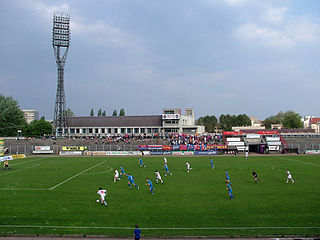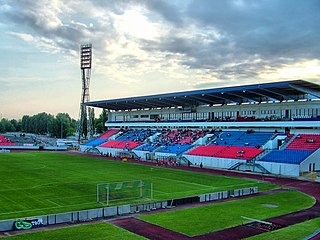The Bozsik József Stadion is currently under construction and going to be a multi-use UEFA category 4 stadium in Budapest, Hungary. The old stadium was demolished completely in 2019. It was used for football matches and was the home stadium of Budapest Honvéd FC. The stadium had a capacity of 7,200.

Stadion Rohonci Út was a multi-purpose stadium in Szombathely, Hungary. It was home to Szombathelyi Haladás. The stadium was able to hold 12,500 people and was built in 1923. It hosted the hammer throw events for the IAAF World Athletics Final as the Stade Louis II in Monaco is too small.

Budai II. Laszló Stadion is a multi-use stadium in Budapest, Hungary. It is currently used mostly for football matches and is the home stadium of Rákospalotai EAC and 1. FC Femina. The stadium was named after Rákospalota-born Hungarian footballer, László Budai. The stadium is able to hold 10,000 people.
The Káposztás utcai Stadion is a multi-use stadium in Sopron, Hungary. It is currently used mostly for football matches and is the home stadium of MFC Sopron. The stadium is able to hold 5,300 people and was reconstructed in 2003.

Fehérvári úti Stadion is a multi-use stadium in Paks, Hungary. It is currently used mostly for football matches and is the home stadium of Paksi FC. The stadium is able to hold 5,000 people.
Városi Stadion is a multi-purpose stadium in Nyíregyháza, Hungary. It is currently used mostly for football matches and is the home stadium of Nyíregyháza Spartacus. The stadium is able to hold 10,500 people.

ETO Park is a multi-use stadium in Győr, Hungary. It is primarily used for football and is home to Győri ETO. Opened in 2008 as a replacement for Stadion ETO, the stadium has a capacity of 15,600.

Dunaferr Arena is a multi-use stadium in Dunaújváros, Hungary, with a capacity of 12,000. It is currently used mostly for football matches and is the home of football club Dunaújváros Pálhalma.
The 2009-10 season will be Debreceni VSC - TEVA's 17th competitive season, 17th consecutive season in the Soproni Liga and 107th year in existence as a football club.
The 2010–11 season will be Debreceni VSC's 33rd competitive season, 18th consecutive season in the Soproni Liga and 108th year in existence as a football club.

Balmazújvárosi Városi Sportpálya is a sports stadium in Balmazújváros, Hungary. The stadium is home to association football side Balmazújvárosi FC. The stadium has a capacity of 2,435.

Mezőkövesdi Városi Stadion is a sports stadium in Mezőkövesd, Hungary. The stadium is home to association football side Mezőkövesdi SE. The stadium has a capacity of 4,183.

The Nagyerdei Stadion is an all-seater asymmetric football stadium in Debrecen, Hungary and home to Debreceni Vasutas Sport Club. With space for 20,340 spectators, Nagyerdei stadion has the third largest capacity of any Hungarian football stadium, preceded by Puskás Ferenc Stadion and Groupama Aréna and the second largest Nemzeti Bajnokság I stadium after Groupama Aréna. The stadium primarily hosts Debreceni Vasutas Sport Club's home matches. It was opened on 1 May 2014 and the first official match was played between Debrecen and Újpest in the 2013–14 season which ended with a 3-1 victory for the host team.

Pancho Aréna is a stadium in Felcsút, Hungary. It is used mostly for football matches and is the home stadium of Puskás Akadémia FC. Between 2015 and 2018 the stadium was the home also for the three-time champions MOL Vidi FC due to the reconstruction of Sóstói Stadion.

Groupama Aréna is a multi-purpose stadium in Budapest, Hungary and the home of Ferencvárosi TC. With a capacity of 22,000, Groupama Arena is temporarily the largest stadium in Hungary. Groupama lies on the grounds of the former Albert Flórián Stadium, the club's previous home, which was demolished in 2013.
Ménfői úti Stadion or Alcufer Stadion is a sports venue in Gyirmót, a district of Győr, Hungary. The stadium is home to the association football side Gyirmót SE. The stadium has a capacity of 4,500.

Szusza Ferenc Stadion is a football stadium in Újpest and the home of Újpest FC. The stadium was designed by Alfréd Hajós and opened on 17 September 1922. The stadium was renovated in 2000-01; its capacity is 14,817.

Illovszky Rudolf Stadion was a multi-use stadium in Budapest, Hungary. It was used mostly for football matches and was the home stadium of Vasas SC. The stadium was able to hold 18,000 people.

Sóstói Stadion was a multi-purpose stadium in Székesfehérvár, Hungary, primarily used for football matches. The stadium could hold 14,300 people and was the home of Nemzeti Bajnokság I club Videoton FC. The football arena was opened in 1967 and set its record attendance on 8 May 1985, when 40,000 fans flocked to see the UEFA Cup Final first leg between Videoton and Real Madrid.


















